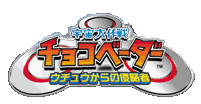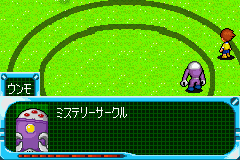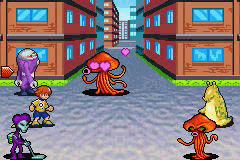Chocovader: Invaders from Beyond Retroview
Take Me to Your Chocolatier
In the history of Japanese RPGs, there have been some games with colorful origins. Chocovader: Uchuu kara Shinrakusha (Invaders from Beyond) has an origin that’s more flavorful than most. “Chocovaders” were a series of collectible figurines sold with cheap chocolates in supermarkets (hence the name). The entire thing was a well orchestrated fad created by Namco, which also produced a series of short animations, an arcade title, and an RPG for the Game Boy Advance, all to support it. Obviously, we’re talking about that last one here.
The hero of the day is Akio, a sixth-grade robot enthusiast who dreams of one day getting the Nobel Prize for engineering. One day, as he deals with normal issues like school bullies and preparations for the big battle robot tournament, a meteorite strikes near his hometown of Yuho, Japan. The “meteor” is actually a sentinel from the planet Unmo, and Akio discovers that he’s been named as an Enlightener, a hero of Earth, by an avatar of the Cosmos. Things only proceed to get weirder from this point onward. Before the dust settles, Akio will have to deal with villainous Men in Black, alien abductors, crop circles in his school’s playground, robotic hitmen, evil geniuses, and the mysteries of pyramid power — and that’s the short list.
Both as a game and as a fad, Chocovader has a focus on collection, but it somehow refrains from becoming an RPG of the monster-collecting sub-genre. There is no mechanic for capturing or persuading enemies to join the player. Instead, aliens will decide to aid Akio at set points in the story, often after he’s had to defeat them in combat. Approximately fifty aliens are available over the normal course of the game, though some are found only after the main part of the plot has been cleared. The other fifty entries in the game’s alien index are mostly duplicates (noted with the omega sign) of previously encountered aliens, but with different skillsets. These can only be obtained by entering passwords into the GBA game, and here’s where it all ties in with the fad. Passwords are obtained in three ways: from Chocovader figurines, from the Chocovader: Contactee arcade game, or from a Namco event. The only exception is the password for the Man in Black (MIBMIBY), which is available on the game’s official homepage.
The alien index is actually kind of fun to read through. It provides a little background information for each alien, making it a miniature encyclopedia of every close encounter and alien sighting in the 20th century. The developers put far more time into researching UFOlogy than more practical studies like physics, architecture, or world geography, that’s for sure.
If one were to draw comparisons, then the closest series to Chocovader in terms of appearance would be the Mega Man Battle Network games. Like them, Chocovader uses the same isometric perspective in its environmental designs. Character designs and sprites are similar, as are the choices of font and text window format. Each of the game’s fifty-some-odd combat sprites (enemies and allies) is well animated with various poses displayed in battle. During combat, the backgrounds are layered, and shift back and forth as attacks are made, giving the illusion of depth and perspective. Outside of battle, the environmental graphics don’t stack up quite so well because of the fact that Manhattan, Las Vegas, and Cairo look nothing like the way they are portrayed in the game. As mentioned before, things like architecture and geography are not the highlights of the story.
Battles in Chocovader are usually three-on-three affairs, with Akio and two aliens of choice (plus four more on the back row) facing off against one to three enemies. Success hinges on two aspects of the system: elemental types and timed button presses. This game has two separate sets of elements — a five-part circle of strengths and weaknesses (fire, ice, earth, electricity, and water) plus a trio of higher elements (light, dark, and dimension). Each alien will possess one of these eight elements, as well as a class type of Battle (physical attacker), Space (beam attacker), or Healing, which also impact physical strengths and weaknesses. While it’s not necessary to take every little thing into account when building a party, it does pay to listen to the guys at the store who dispense info on the local enemy types.
The active part of the battle system lies in the Advances and Barriers. Advances are critical hits that rely on a timed press of the A button. Every alien ally has a different attack pattern when used, and thus a different window of opportunity for Advances. Aside from doubling the power of an attack, Advances also guarantee success for status attacks (unless properly defended against). Barriers are force fields activated with the B button. Like the Advances, there’s only a limited window of opportunity to use them that is dependent on the attacker. Some aliens are much easier to defend against than others. Unlike Advances, Barriers aren’t automatically synced with the person being targeted. There’s a cursor that must be moved up and down to designate who is currently mapped to the B button. The game tallies up the total number of successes and failures at the end of each battle, assigning a letter grade at the same time. With each successful timed press of a button, the AD Gauge at the top of the screen charges a little. When full, Akio can use one of his powerful Enlighten attacks, or an alien character can summon his/her/its own UFO to aid in battle.
Akio is the wild card of the battle system. His element is naturally neutral, and his attack patterns vary both on his current equipment and whatever special attack he’s using. He is also the only customizable character in the game, thanks to the Gadget system. Gadgets are equippable skills and support attributes that can be learned from friendly aliens. They’re purchased with Energy Points (EP), which are gained whenever Akio or an ally levels up. The system is weighted slightly to encourage players to switch up their lineup of six active allies on a regular basis.
Many Gadgets are active skills for use in battle, but there’s also a wide variety of passive ones as well. Most important are the elemental Gadgets. Akio can equip one of these to change his base element, and thus his defenses. They can also be used for tinkering. If Akio tinkers with two elemental Gadgets of the same type, he can make a stronger level of Gadget, e.g. combining two Water Gadgets to make a Flood Gadget, then adding another to make a Torrent Gadget. Besides incrementally increasing his defense against a different element (in this case, Fire), these elemental Gadgets can be combined with weapon parts to make stronger attack skills for Akio. It’s also possible to quickly disassemble any tinkered Gadgets, making Akio’s ability set even more easily manageable.
The sound in Chocovader is about what one would expect of a GBA title, though sometimes it slides towards the better end of the spectrum. It’s full of beeps, bloops, and other sounds appropriate to the B-movie atmosphere of the game. While it’s not likely to hold the attention for long, it works well in context.
While this title may have been a cash-in on a fad, Chocovaders stands up fairly well as a game in its own right. It has a battle system that requires active participation, a shonen manga plotline that balances serious scenes with silly and cheesy moments, and a final boss that’s actually a challenge to defeat. All this is contained in an RPG that can be finished in just under twenty hours. It may not be a great title, but it has definitely been a pleasure to play.


Wide variety of alien types
1Active player participation in battle
Never takes itself too seriously
Level and town designs are generic
Some Gadgets seem superfluous
Difficult to find passwords nowadays








Recent Comments